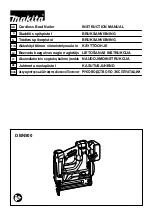
IM50S COILMASTER MANUAL 4
BATTERY SAFETY & CHARGING
BATTERY AND CHARGING INSTRUCTIONS
1. Plug power adapter into charger base.
2. Connect to 240v AC outlet, a green light
indicates power is on.
3. Install battery, red light indicates battery is charging.
NOTE:
If battery is completely discharged, the red
light and the green light may alternate back and
forth for up to 20 minutes. This safety feature slowly
recharges the battery until it is ready to accept the
full charging current. If the red and green lights
continue to alter nate after 20 minutes, the battery
may be damaged.
4. After charging is complete, the green light will come on.
CHARGING TIMES
First charge (new battery) - 1 hour
Discharged Battery - 5 minutes to 1 hour
DO NOT:
Charge battery outdoors, in exposed wet
conditions, or in temperatures below 5°C
(40°F).
Allow metal objects to come in contact with
battery terminals.
Puncture or attempt to open battery case
or cells.
Store battery where it will be subjected to
temperatures above 49°C (120°F).
Incinerate battery.
Use a defective battery charger, one that
over-heats and/or smokes when plugged in.
Immerse the battery in water.
Do not short-circuit a battery.
Do not use a battery charger which heats
up excessively or gives off fumes when
connected - disconnect the charger
immediately.
The power adapter, charger base and battery are
designed to operate together as one system. Only use the
‘Paslode Impulse’ charger for ‘Paslode Impulse’ batteries.
The charging system is designed for use in covered areas.
Do not expose it to rain or to excessive humidity.
Arrange the charger lead appropriately to avoid
unnecessary damage. Do not use the charger if the cable
or plug is damaged. Replace immediately.
To avoid electrocution, disconnect the power supply
adapter before cleaning the terminals and contacts.
Use a dry cloth.
BATTERY DISPOSAL
Batteries and charging systems must be recycled or
taken to a designated disposal areas. (Subject to local
regulations)
TRANSPORT - LI ION BATTERY
& FUEL CELLS
The contained lithium-ion batteries are subject to the
Dangerous Goods Legislation requirements (see UN3480
or UN3481). The user can transport the batteries by road
without further requirements.
When being transported by third parties (eg: air transport
or forwarding agency), special requirements on packaging
and labelling must be observed. For preparation of the
item being shipped, consult an expert for hazardous
material if required.
Dispatch batteries only when the housing is undamaged.
Tape or mask off open contacts and pack up the battery
in such a manner that it cannot move around in the
packaging. Please also observe possibly more detailed
national regulations.
For the transport of Paslode fuel cells use UN Code
UN3478.
Transport of small amounts (<30 Kg ) in a private vehicle
is permitted without a transport and safety sheet (Limited
quantity exemption for road transport). The regulations by
transport categories are:
• Road/rail: ADR- RID - UN code 3478 class 2 code 5F
• Sea: IMDG - UN code 3478 + emergency instructions
sheet F·D, S-U
• Air: IATA - UN code 3478 class 2.1
Goods must be accompanied by the written safety
instruction of the chapter 5·4·3 of the ADR. Transport
by post is not permitted.


































